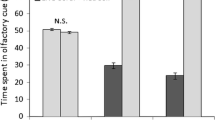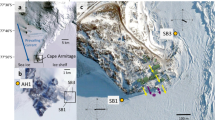Abstract
Chemical signals affect recruitment of organisms in many habitats. Most of the described biogenic chemical moieties in marine environments elicit specific positive responses, for example, of predators to prey or of conspecific larvae to suitable habitats. However, organisms also release noxious chemicals that may elicit negative responses from neighboring members of the assemblage. Herein we measured the effect on recruitment of the release of such compounds (halogenated aromatics) into sediments. The common, sediment-dwelling, terebellid polychaeteThelepus crispus contains brominated aromatic metabolites and contaminates the sediments surrounding its tube with these compounds. Sediments so contaminated are actively rejected by recruitingNereis vexillosa (Nereidae: Polychaeta). Interestingly, many of these noxious biogenic compounds have low solubility in water and, therefore, potentially long residence times in sedimentary environments. The negative response of larvae to sediment contaminated with them is a novel, potentially common, and very important mechanism in which sediment-dwelling organisms release haloaromatic compounds and thus impose a recruitment filter on their community.
Similar content being viewed by others
References
Aller, R.C., 1982. The effects of macrobenthos on chemical properties of marine sediment and overlying water, pp. 53–102,in P.L. McCall and M.J.S. Tevesz (eds.). Animal-Sediment Relations. Plenum Press, New York.
Aller, R.C., andYingst, J.Y. 1985. Effects of the marine deposit-feedersHeteromastus filiformis (Polychaeta),Macoma balthica (Bivalvia) andTellina texana (Bivalvia) on averaged sedimentary solute transport, reaction rates and microbial distributions.J. Mar. Res. 43:615–645.
Ashworth, R.B., andCormier, M.J. 1967. Isolation of 2,6-dibromophenol from the marine hemichordateBalanoglossus biminiensis.Science 155:1558–1559.
Braekman, J.C., andDaloze, D. 1986. Chemical defence in sponges.Pure Appl. Chem. 58:357–364.
Buhr, K.-J. 1976. Suspension-feeding and assimilation efficiency inLanice conchilega (Polychaeta).Mar. Biol. 38:373–383.
Butman, C.A. 1987. Larval settlement of soft-sediment invertebrates: The spatial scales of pattern explained by active habitat selection and the emerging role of hydrodynamical processes.Oceanogr. Mar. Biol Annu. Rev. 24:113–165.
Chen, Y.P., Lincoln, D.E., Woodin, S.A., andLovell, C.R. 1991. Purification and properties of a unique flavin-containing chloroperoxidase from the capitellid polychaeteNotomastus lobatus.J. Biol. Chem. 266:23909–23915.
Davis, A.R., Targett, N.M., McConnel, O.G., andYoung, C.M. 1989. Epibiosis of marine algae and benthic invertebrates: Natural products chemistry and other mechanisms inhibiting settlement and overgrowth, pp. 85–114,in P.J. Scheuer (ed.). Bioorganic Marine Chemistry, Vol. 3. Springer-Verlag, Berlin.
Dawidowicz, P., Pijanowska, J., andCiechomski, K. 1990. Vertical migration ofChaoborus larvae is induced by the presence of fish.Limnol. Oceanogr. 35:1631–1636.
Emerson, S., Jahnke, R., andHeggie, D. 1984. Sediment-water exchange in shallow water estuarine sediments.J. Mar. Res. 42:709–730.
Emrich, R., Weyland, H., andWeber, K. 1990. 2,3,4-Tribromopyrrole from the marine polychaetePolyphysia crass.J. Nat. Prod. 53:703–705.
Faulker, D.J. 1984. Marine natural products: metabolites of marine algae and herbivorous molluscs.Nat. Prod. Rep. 1:251–280.
Feeny, P. 1976. Plant apparency and chemical defense.Recent Adv. Phytochem. 10:1–40.
Goerke, H., andWeber, K. 1991. Bromophenols inLanice conchilega (Polychaeta, Terebellidae): The influence of sex, weight and season.Bull. Mar. Sci. 48:517–523.
Goerke, H., Emrich, R., Weber, K., andDuchene, J.-C. 1991. Concentrations and localization of brominated metabolites in the genusThelepus (Polychaeta: Terrebellidae).Comp. Biochem. Physiol. 99B:302–206.
Grosberg, R.K. 1981. Competitive ability influences habitat choice in marine invertebrates.Nature 290:700–702.
Gust, G., andHarrison, J.T. 1981. Biological pumps at the sediment-water interface: mechanistic evaluation of the Alpheid shrimpAlpheus mackayi and its irrigation pattern.Mar. Biol. 64:71–78.
Hadfield, M.G. 1984. Settlement requirements of molluscan larvae: New data on chemical and genetic roles.Aquaculture 39:283–298.
Hanazato, T. 1991. Effects of aChaoborus-released chemical onDaphnia ambigua: Reduction in the tolerance of theDaphnia to summer water temperature.Limnol. Oceanogr. 36:165–171.
Hay, M.E., andFenical, W. 1988. Marine plant-herbivore interactions: The ecology of chemical defense.Annu. Rev. Ecol. Syst. 19:111–145.
Higa, T., andScheuer, P.J. 1975. Constituents of the marine annelidThelepus setosus.Tetrahedron 31:2379–2381.
Higa, T., andScheuer, P.J. 1977. Constituents of the hemichordatePtychodera flava laysanica, pp. 35–43,in D.J. Faulkner and W.H. Fenical (eds.). Marine Natural Products Chemistry. Plenum Press, New York.
Higa, T., Fujiyama, T., andScheuer, P.J. 1980. Halogenated phenol and indole constituents of acorn worms.Comp. Biochem. Physiol. 65B:525–530.
Higa, T., Okuda, R.K., Severns, R.M., Scheuer, P.J., He, C.-H., Changfu, X., andClardy, J. 1987. Unprecedented constituents of a new species of acorn worm.Tetrahedron 43:1063–1070.
Highsmith, R.C. 1982. Induced settlement and metamorphosis of sand dollar (Dendraster excentricus) larvae in predator-free sites: Adult sand dollar beds.Ecology 63:329–337.
Johnson, L.E., andStrathmann, R.R. 1989. Settling barnacle larvae avoid substrata previously occupied by a mobile predator.J. Exp. Mar. Biol. Ecol. 128:87–103.
Johnson, M.W. 1943. Studies on the life history of the marine annelidNereis vexillosa.Biol. Bull. 84:106–114.
King, G.M. 1986. Inhibition of microbial activity in marine sediments by a bromophenol from a hemichordate.Nature 323:257–259.
Knox, G.A. 1977. The role of polychaetes in benthic soft-bottom communities, pp. 547–604,in D.J. Reish and K. Fauchald (eds.). Essays on Polychaetous Annelids. Allan Hancock Foundation, University of Southern California, Los Angeles.
Meyers, M.B., Fossing, H., andPowell, E.N. 1987. Microdistribution of interstitial meiofauna, oxygen and suicide gradients, and the tubes of macro-infauna.Mar. Ecol. Prog. Ser. 35:223–241.
Morse, A.N.C., andMorse, D. 1984. Recruitment and metamorphosis ofHaliotis larvae induced by molecules uniquely available at the surfaces of crustose red alga.J. Exp. Mar. Biol. Ecol. 65:191–215.
Paul, V.J. 1987. Feeding deterrent effects of algal natural products.Bull. Mar. Sci. 41:514–522.
Pawlik, J.R., Butman, C.A., andStarczak, V.R. 1990. Hydrodynamic facilitation of gregarious settlement of a reef-building tube worm.Science 251:421–424.
Peterson, C.H., andPeterson, N.M. 1979. The Ecology of Intertidal Flats of North Carolina: A Community Profile. Fish and Wildlife Service, Office of Biological Services. FWS/OBS-79/ 39, 73 pp.
Rhoads, D.C., andBoyer, L.F. 1982. The effects of marine benthos on physical -properties of sediments: a successful perspective, pp. 3–52,in P.L. McCall and M.J.S. Tevesz (eds.). Animal-Sediment Relations, The Biogenic Alteration of Sediments. Plenum Press, New York.
Rice, D.L. 1986. Early diagenesis in bioadvective sediments: relationships between the diagenesis of beryllium-7, sediment reworking rates and the abundance of conveyor-belt deposit feeders.J. Mar. Res. 44:149–184.
Roe, P. 1975. Aspects of life history and of territorial behavior in young individuals ofPlatynereis bicanaliculata andNereis vexillosa (Annelida, Polychaeta).Pac. Sci. 29:341–348.
Rosenthal, G.A., andBerenbaum, M.R. 1991. Herbivores. Their Interactions with Secondary Plant Metabolites, 2nd ed. Academic Press, San Diego.
Roughgarden, J., Gaines, S.D., andPossingham, H.P. 1988. Recruitment dynamics in complex life cycles.Science 241:1460–1466.
Sheikh, Y.M., andDjerassi, C. 1975. 2,6-Dibromophenol and 2,4,6-tribromophenols-antiseptic secondary metabolites ofPhoronopsis vendis.Experientia 31:265–266.
Steinberg, P.D. 1985. Feeding preferences ofTegula funebralis and chemical defenses of marine brown algae.Ecol. Monogr. 55:333–349.
Strathmann, M.F. 1987. Reproduction and Development of Marine Invertebrates of the Northern Pacific Coast. University of Washington Press, Seattle.
Suer, A.L., andPhillips, D.W. 1983. Rapid, gregarious settlement of the larvae of the marine echiuranUrechis caupo Fisher and MacGinitie 1928.J. Exp. Mar. Biol. Ecol. 67:243–259.
Thayer, C.W. 1983. Sediment-mediated biological disturbance and the evolution of marine benthos, pp. 480–625,in M.J.S. Tevesz and P.L. McCall (eds.). Biotic Interactions in Recent and Fossil Benthic Communities. Plenum Press, New York.
Tjossem, S.F. 1990. Effects of fish chemical cues on vertical migration behavior ofChaoborus.Limnol. Oceanogr. 35:1456–1468.
Underwood, A.J., andDenley, E.J. 1984. Paradigms, explanations, and generalizations in models for the structure of intertidal communities on rocky shores, pp. 151–180,in D.R. Strong, Jr., and D. Simberloff, L.G. Abele, and A.B. Thistle (eds.). Ecological Communities: Conceptual Issues and the Evidence. Princeton University Press, Princeton, New Jersey.
Weber, K., andErnst, W. 1978. Occurrence of brominated phenols in the marine polychaeteLanice conchilega.Naturwissenschaften 65:262.
Woodin, S.A. 1991. Recruitment of infauna: Positive or negative cues.Am. Tool. 31:797–807.
Woodin, S.A., andMarinelu, R.L. 1991. Biogenic habitat modification in marine sediments: The importance of species composition and activity, pp. 231–250,in P.S. Meadows and A. Tufail (eds.). The Environmental Impact of Burrowing Animals and Animal Burrows. Zoological Society, London, No. 63.
Woodin, S.A., Walla, M.D., andLincoln, D.E. 1987. Occurrence of brominated compounds in soft-bottom benthic organisms.J. Exp. Mar. Biol. Ecol. 107:209–217.
Author information
Authors and Affiliations
Rights and permissions
About this article
Cite this article
Woodin, S.A., Marinelli, R.L. & Lincoln, D.E. Allelochemical inhibition of recruitment in a sedimentary assemblage. J Chem Ecol 19, 517–530 (1993). https://doi.org/10.1007/BF00994322
Received:
Accepted:
Issue Date:
DOI: https://doi.org/10.1007/BF00994322




